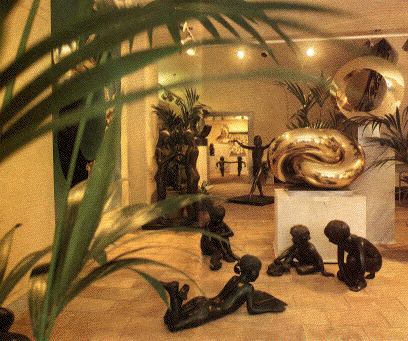
Figure 1: Gallery
[`The symbolic sculptures of John Robinson', in Theoria et Historia Scientiarum, the International Journal of Interdisciplinary Studies, issue on `Knowledge: representation and interpretation.', edited W. Meyer and R. Paton, 6 (2002) 55-73.]
The aim of this article is to explore the questions of knowledge representation and interpretation in the context of the Universe Series of Symbolic Sculptures by John Robinson. The intention is to point out some questions, and ask for help in pursuing them.
One reason for this article is that in the broad sweep of this volume it seemed reasonable for art to have some place. Certainly an artist is involved with representation and interpretation. This is particularly clear in Robinson's work, with his notion and use of `symbol' which we will explore later. This leaves the open question of whether we should call the work of an artist `knowledge'. Asking this question is in no way intended to devalue art, and it may be even be doing the opposite. It is partly a question of use of words.
We surely all know that there are different modes of thought - we can think in words, in concepts; a painter will think in terms of colour, form and paint; a musician in terms of sound; a ballet dancer in terms of movement of the body; a mathematician in terms of geometry, symbols, and the structure of mathematical forms; and so on. Any expression in terms of one of these modes involves knowledge of that form: as Haydn said to Mozart's father: `He knows more on music than any one else alive.' Many artists are able to explain verbally what they are trying to achieve, for example in the production of a play. Though such words are but a sketch, a plan, of the actual work, they are valuable, as indicating structure and plans, which control execution.
In mathematics we have the notion of `metamathematics', the mathematics of mathematics, and indeed we have a mathematics of mathematical structures, which is known as `category theory'. This suggests that these different levels of discussion, and cross reference across levels, are important in a range of activities, or indeed in any activities, such as for example planning a holiday.
We can also ask what the public at large expect of art. Perhaps I should speak only for myself and say that I like to see:
rhythm, proportion, craftsmanship, surprise, significance,
and that the first four, which are involved with execution, should be related to the fifth, significance, or meaning.
In 1985, having half an hour to spare, I walked into a gallery in Albermarle St, just off Picadilly in London, and was gobsmacked to see realistic sculptures of children living happily with strong and beautifully crafted abstract bronze forms.

Figure 1: Gallery
Some of the forms were knotted, and as I collected knot forms to go with a general lecture on the mathematics of knots, I got in touch with the artist, John Robinson. A series of chances led to a collaboration on presenting his work. In 1988 I was asked to help with an exhibition on knots to go with a Royal Institution Friday Evening Discourse by Sir Michael Atiyah. I suggested John's sculptures among other possibilities, and these were very successful. It then occurred to me that he could perhaps solve a problem I had. A team at Bangor had been preparing an exhibition on Mathematics and Knots for the Summer,1989, Pop Maths Roadshow at Leeds University. Originally, we had wanted to include knots in history, art, and practice, but there was just too much material to sort through to make a sensible presentation. So I suggested that to John that perhaps he could present an exhibition of his work, to show an artistic side of knots and of mathematical forms. He thought that in nine months we could do something grand.
In April, 1989, we met at John's suggestion at his home in Somerset to discuss the choice of sculptures, and then to drive to Leeds to decide how and where they could be shown. John's garden seemed to me magic, with trees and bronze sculptures of children and abstract forms. I was also astonished to learn of his career. Fed up with life at an English public school, even though he won prizes for geometry and sculpture, he left at 16 to join the Merchant Navy, then stopped off at Australia where his family had connections. He spent years cattle droving, trecking with police patrol in the Kimberlies, before settling for ten years to create a sheep farm in the Ninety Mile Desert, and raise a family. Towards the end of this period, he bought some modelling clay and began to model friends and children. An example is James.
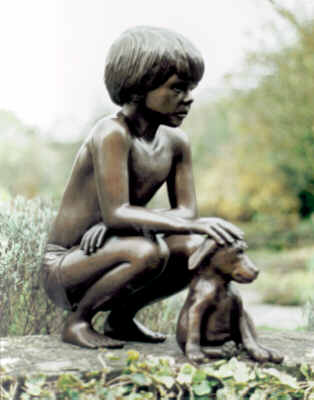
Figure 2. James. (Life size commission)
It seems to me that part of the general appeal of John's work wherever it is shown arises not just from his extraordinary talent but also from his many years working and living with a wide variety of people, in particular on a farm with the standard cycle of birth, life and death.
A foundation for his later work was his fascination with astronomy, based on the astonishing views of the Southern night sky from his farm. He bought a telescope, and read Hoyle's Frontiers of Astronomy, where he learned that, as John puts it, "our bodies are made of star dust". This `interpretation of knowledge', to reflect the theme of this volume, later led to his sculpture Star Burst:

Figure 3. STAR BURST HEIGHT 15INCHES (38CMS)
STAINLESS STEEL 1996
"our bodies are composed of star dust"
"In fact everything that I touched, saw, ate, and loved, all the forms of life that lived on the earth, the whole Solar System, we were all created brothers by Star Dust."
To continue the story, he was then moved to try his hand at becoming a sculptor (not uninfluenced by the heat and the flies of an Australian desert Summer), sold his sheep farm, and took his family to England, since Europe is the Mother of Western Art. He made a career with sculptures of children at play and rest, lovers, mother and child, and sports men as if captured in motion. His `Acrobats' is outside the Sports Centre in Canberra, where Kodak have installed bronze plaques for photographers to stand to get the best snap of this and also of `Pole Vaulter'.
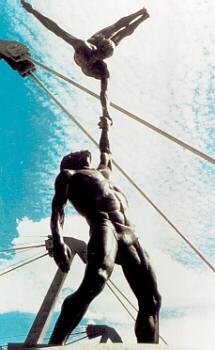
Figure 4 Acrobats
Australian National Sports Centre, Canberra, Australia
( Height 16 Feet )
In 1975 he conceived the Universe series, which "traces a path from the beginning of time to the present day, ... the whole collection symbolically portrays the earth, animals, man and woman, birth, religion, civilisation and death". It seems that Robinson has already been working in a way asked for by the physicist and Nobel Prize winner Richard Feynman, when he wrote (Feynman, :
`My idea was that artists don't understand the underlying generality and beauty of nature and her laws (and therefore cannot portray this in their art).'
`Never concerned that the answer may prove disappointing, with pleasure and confidence we turn over each new stone to find unimagined strangeness leading on to more wonderful questions and mysteries - certainly a grand adventure!
It is true that few unscientific people have this particular type of religious experience. Our poets do not write about it; our artists do not try to portray this remarkable thing. I don't know why. Is no one inspired by our present picture of the universe? This value of science remains unsung by singers; you are reduced to hearing not a song or poem, but an evening lecture about it.' (Feynman, 1988).
The notion of `symbol' is a key theme of the Universe Series and is illustrated by the contrast between the figurative sculpture `Acrobats' and the symbolic sculpture `Elation':
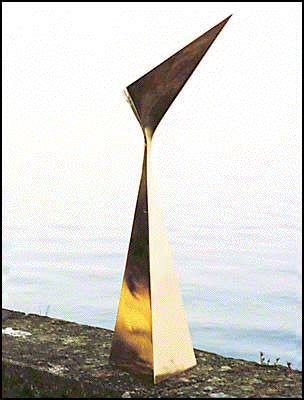
Figure 5: Elation
HEIGHT 9FT (3M) POLISHED BRONZE 1983
"Exaltation of Spirit"
John writes: "I was looking for a symbol to represent the same emotions expressed by the power of the figures. Balance, made possible by physical fitness combined with a will to achieve and the joy of succeeding. I also wanted to capture the essence of the Golden Rule in the symbol. ELATION to me is the perfect example of how a Symbolic Sculpture can say so much more to the viewer than a figurative one. I did the ACROBATS in 1970. For me the Symbolic version ELATION stretches the mind with emotions and images and `exalts the spirit'."
Another interesting contrast between symbolic and figurative sculpture is shown in
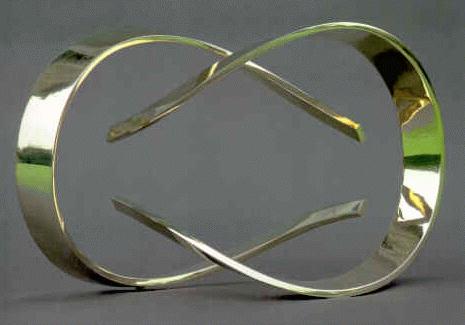
Figure 6: LOVE KNOT
HEIGHT 10 INCHES POLISHED BRONZE 1978
"Forming Union"
"LOVE KNOT was one of the earliest of my Symbolic Sculptures. I had done a figurative sculpture of an embracing couple, entitled 'AWAKENING', in which I had tried to capture the first moments of the tender love of youth. I wanted to try and do the same thing with a Symbol. I cut the section of the sculpture from a hollow cone, cast two and then mounted them to face each other. I see the image not only as a tender kiss, but as the arms of the lovers forming a knot that will tie them together for life, as a couple, the foundation of a family. I have found that when I cut a shape from a geometric body like a cone, an ovoid, or a sphere, the balance of the whole form is carried into the section."
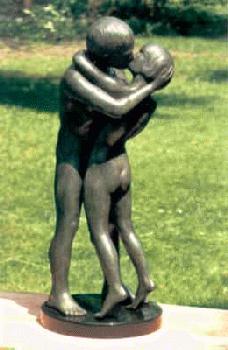
Figure 7: Awakening
John is a remarkble experimental geometer. He explains that he found the form of `Rhythm of Life' by wrapping ribbon around an inner tube.

Figure 8: Rhythm of Life
HEIGHT 5FT (1.5M) POLISHED BRONZE AND PAINTED
STAINLESS STEEL 1982
"DNA spinning within the Universe"
"What a marvellous surprise when I found that, on the fourth trip round, the ribbon returned to its point of origin. I created the sculpture about the time that the miracle of DNA had just been discovered, and for me, this delightful flowing ribbon summed up the continuity of the Genes." In fact the form he created is known to mathematicians as a (15,4)-torus knot, where `torus' is the mathematical term for the inner tube shape, and the knot winds fifteen times one way and four times the other round the tube. It is important that the numbers 15 and 4 are coprime, that is have no common divisors, otherwise the form would split into pieces.
It is helpful to have the background to appreciate fully what John is conveying, to see how the sculpture was made and conceived. Some argue that this necessity detracts from the value of the work. It is said that a work of art should stand by itself, convey its own world, and not require words or other explanation than itself. As an example, no one expects to give any other name to Mozart's Symphony No. 40, nor to give any `explanation'. However, music also has other roles, and we do expect the music in opera to point the words and the action. Thus in `Marriage of Figaro', the music for all the characters adds to our knowledge and understanding of their feelings and actions, and in ways which can be only partly expressed or indicated in words. However such expression may be very useful for a producer of the opera to convey to his artists his ideas on the production.
This suggests that a separation of `knowledge' from communication may be a lack of recognition of and study of the practice used by people in relation to knowledge, and so may give only a limited view. This separation of analysis from study of the practice occurs in other subjects: for example there is a subject of the `philosophy of mathematics' which studies mainly what mathematicians produce rather than what they do, and tries to give an intrinsic justification of the results of their work. However the results, their presentation and their interpretation, are influenced by the practice and prejudices of the time, whereas it may be suspected that there is a commonality in method when we are confronted by a difficult problem. Thus the philosophy of mathematics does not help an aspiring mathematician, whereas an analysis of practice should help a young person in passing more quickly to a productive stage.
We can thus sense that art can be related to knowledge through the power to communicate, by involving many senses and their relations, including the imagination. This communication is enhanced, even made possible, through the use of rhythm, proportion and surprise, welded together by craftmanship.
I am also interested in the relation of these ideas to mathematics. A common ground between John and I is the notion of structure. This notion is explored in relation to mathematics in the article by Tim Porter and the author in another essay in this volume. In relation to sculpture we can see one aspect also in the sculpture `Creation'.
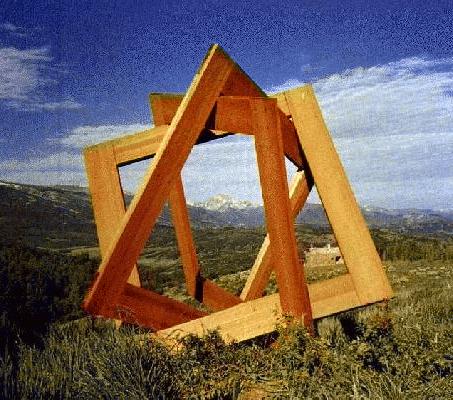
Figure 9: CREATION (1991)
HEIGHT 12 x 12FT (4x4M)
REDWOOD PLANK CONSTRUCTION
This is made of three squares with the remarkable property that if you remove any one square the others are unlinked, can be separated. Thus the whole is more than the sum of its parts. This is one simple illustration of the magic of life, of the shallowness of the notion of `reductionism', which suggests for example that we are only composed of atoms, or that the Universe can be `reduced' to a few equations. The fact is that the form, the structure of `Creation', which is a version of the famous Borromean Rings, has a strong element of surprise, of the unexpected, even though its existence is but a consequence of geometry. To find and describe the consequences of axioms, of rules, we may need a whole new shaft of concepts, and the effort of finding these is often considerable. It was described by my friend Alexander Grothendieck, a 20th century master of new mathematical concepts, and whose work was in fact a necessary foundation for the work of Wiles on Fermat's Last Theorem, as the "difficulty of bringing new concepts out of the dark". It is these concepts which we use to represent and interpret what is happening.
It has been said by the great genetecist Dobzhansky that "In biology, nothing is comprehensible except in the context of evolution". So we must presume that our ability to form concepts is also seen in animals, and that it has evolved as a part of dealing successfully with the world, of surviving. In view of the complexity of the world, we must make maps, simplified versions of the world, giving structure to our experience, and the ability to make such maps, and the kinds of maps we or other animals can make, has been developed over hundreds of millions of years. These maps are somehow encoded, hard wired in many aspects, into our brains. So we see that the notion, the concept itself, of abstract structure, which exists independently of its realisation, is already there in nature.
Our claim is that it is these notions of abstract structure which are studied in mathematics. On the other hand it is argued in contradiction that pattern and structure are the subject of all sciences, so what is special about mathematics? The answer must be found in the practice of mathematicians, since the dividing line between activities is necessarily blurred. Mathematicians have found modes of symbolic representations of concepts, and methods of deduction and calculation with these in a rigorous form. It is this degree of certainty of its conclusions which has been its general value, since it has enabled many aspects of commerce, engineering and travel, to name a few.
It is also important that some trivial ideas can be crucial. A famous example is the number zero: "mathematics was held up for centuries for the lack of this trivial concept" (Grothendieck, 1983). The number zero is a necessity in the Arabic number system, and this allowed the possibility of successful computations in double entry book keeping, and so the commercial success of the Venetian Empire! All this arose from giving a name to the number of elements in an empty box!
Thus the notion of a `name' is an essential part of knowledge, and its representation and communication. A commonality of understanding of names is essential for communication. Of what use is: "Here's rosemary, that's for remembrance." in a society which has no knowledge of common herbs used in cooking. One is also reminded of the description of the role of the poet in Midsummer Night's Dream: "To give to airy nothing a local habitation and a name." For a sculptor the "habitation" has to be in the form. Thus we have John's remarkable description of the conception of the Universe Series, which started with his sculpture `Adagio'.
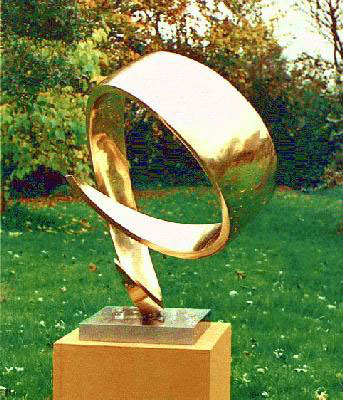
Figure 10: ADAGIO (1980)
HEIGHT 3FT (1M)
POLISHED BRONZE
"The first ten years of my sculpting career were spent doing Figurative Works. To earn my living I specialised in sculpting life-size children in clay, and having them cast in bronze. Although I love children and capturing their likenesses and activities, after doing over 100 commissions the subject matter was no longer stimulating me artistically. I was now 45 years old, and subconsciously I was looking for a new form in which to express all the things that I had learnt of `life', something unique to myself.
I have always been interested in the prehistory of Modern Man, especially the art, and its use of Symbols. One evening, after listening to Mozart's Third Violin Concerto, I was sitting in the dark, thinking about the commencement of the Adagio movement. The solo violin theme grows and swells into a beautiful phrase. A sculpture, which for me captured that theme, appeared in my mind's eye, as a Symbol. Next day I made the sculpture ADAGIO in plaster. The experience was as exciting and intense as any feeling I have had in my life.
This was how my first SYMBOLIC SCULPTURE was born. The experience was so exhilarating that I started to look for other values of `life' that could be expressed symbolically. I found that I had opened a flood gate and over the last 15 years I have been blessed with a stream of images, many of which are represented in these pages [of the web site]. ADAGIO as my first baby, has a special place in my heart."
What is also interesting from the point of view of the subject of this volume is how in John's sculpture experimentation with a form can then, for him and so for us, lead to a symbol. Just one example is `Gordian Knot'.
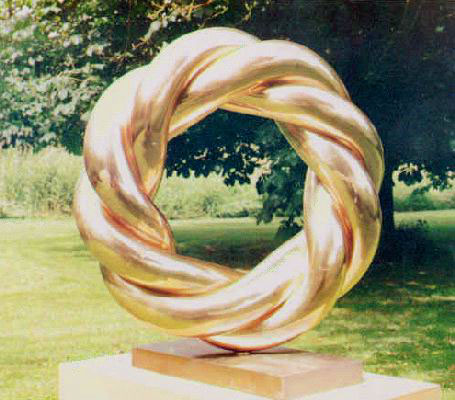
Figure 11: GORDIAN KNOT (1982)
HEIGHT 3FT (1M) POLISHED BRONZE
"The Unknown"
"Having discovered with ETERNITY and DEPENDENT BEINGS the magic of what could be done with a circle and a tile that had a hole in the middle, I had to experiment with curved surfaces. What would happen if I used the club design of a three leaf clover ? When the sculpture started to take form I found that from this combination appeared a beautiful endless triple rope. I named the sculpture GORDIAN KNOT, after the puzzle posed to Alexander the Great, which he solved by cutting the knot with his sword ! Following the strand by eye is certainly confusing, so I can understand his resorting to cutting it."
The mathematics of this type of form is described in the website [loc. cit.] under the general term of torus knots. John is also interested in structure as influencing evolution. "After completing the sculpture LIFE in which I tried to depict my ideas about Replicators as a sphere of rhombuses, the next step was to try and create out of the same forms a symbolic sculpture for EVOLUTION
. 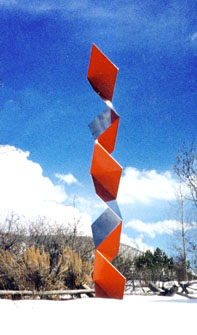
Figure 12: EVOLUTION 1. (1997) First View
HEIGHT 6FT ( 180CMS) STAINLESS STEEL
"a chain of coincidences, governed by geometry"
"When I put together the column of EVOLUTION, I marked one side of each diamond by painting it red, then assembled the column in an alternating format, so when the viewer walked around the sculpture, it would hopefully give a sense of changing combinations. On the 4th of December 1872 Charles Darwin wrote to Alpheus Hyatt at Harvard. In the letter he said: "after long reflection I can not avoid the conviction that no innate tendency to progressive development exists "."
I commented to John: "But perhaps there is a tendency to complexity, governed by the geometry of forms, and the laws of physics. This development also seems to evolve on the border between chaos and total stability, fed by energy, and allowing complex forms to evolve and interact".
To come back to the title of this volume, the first four of our potential qualities of art are concerned with representation, and the fifth with interpretation, although the dividing line may be thin. In order to contrast art with other activities, such as mathematics, it has also been said that "Art gives a foothold to emotion." (I am currently unable to trace the quotation.) This does seem a valuable distinction, and also reflects an aspect of our evolutionary development. T. Gold has developed this theme in correspondence with John, and I am grateful for his permission to quote him here.
"I think of the development of art and symbolism in the following way: it is a way of making inroads into the emotional configuration of a person's brain without going through the intellectual screening, which would normally be the first barrier for incoming information. I see this strange possibility as a result of a strange evolutionary history.
In vertebrate development, there has long existed a vocal and visual communication for major emotional dimensions. Fear, sadness, happiness, aggression, have all their sounds which we, together with many other large mammals, have still in common. No one doubts the meaning opf the roar of a lion or of the tweet of a baby. Even facial expressions are still shared and recognised among large mammals.
The way I believe this came about is that the brain is constructed essentially in two levels. Firstly, there is a system of neurons working with electrical impulses, and arranged in the most complicated intricate network. Working within this system the response times are reckoned in milliseconds. Then, superimposed on all this, is a second system which in fact is the older in the evolutionary chain, in which chemical information is disseminated, and causes the setting of a lot of switches into certain patterns. This is a slow system, in which the times are reckoned in seconds, and it is a system which we associate with the emotional condition in which we are. Fright, attack, submission, and whatever other dimensions there may be in the emotional condition, are mediated by this chemical system.
What I believe happened in the development of communication is that it was at first concerned entirely with the emotional system, and for this reason it spans over such a long period of evolution that it still gives us common ground with so many other animals. In this system, an animal could say "I am in distress, help me" or "I am going to attack you" and these messages would set the chemical signals in the recipient's brain. But that was all this that this type of information could convey; there was no way of being more specific.
Then, suddenly, the more specific, detailed "logical" language was developed., certainly in the human branch of evolution, but perhaps also in some other animals like the dolphins. It quickly crowded out the older communication systems. Now the details of a situation could be communicated; you could call out not only "I am in distress" but you could say "I am about 200 yards north of you, I am being attacked by a cobra". The intellectual communication channel became so dominant that we tend to forget that the other one still exists. Of course we all recognise the emotional state of a person by the intonation he gives to his speech, or by his facial expression or the attendant noises of crying or laughing.
What I think happened before this intellectual communication was invented, was, that in the long history of human evolution, the emotional communication system had progressed very much further than we now know. The development of music and visual arts, as a way of influencing the emotions, had become well established. Community behaviour was controlled and dominated by this. It is only in this way that I could understand why such a complicated thing as the emotional content of music could be so widely and generally understood in human society now; or why the emotional symbolism of an orator should have such a wide appeal. All this is due to the continued recognition by us of this earlier communication system, once the dominant or indeed the only one, highly developed then but now neglected and largely supplanted by the logical, intellectual communication. The emotional communication system had probably gone very far in producing group sentiments, group behaviour. This of course is the case with many animals, but ion human evolution it had probably gone much further still, and involved with much more complex matters like elaborate music, singing, dancing, as well as complex visual symbolism. An anthem, a flag, a pyramid, a swastika, a cathedral, are all components of such a symbolism for group behaviour which we still honor, as apparently much of humanity is affected by the emotional expression of orators, be it a Hitler or a Mussolini, or a Jesse Jackson of Billy Graham. Woodstock represented a symbolism of this kind. Perhaps we can see the importance of such symbolism remains even greater in the more primitive societies.
But this is not to attempt any value judgement. Group behaviour is a delicate and important matter for the survival of the species. The communication systems that evolved for this purpose must not be abandoned lightly. The conflicts that we now see between the new and the old should not cause us to abandon the old, but only to adapt the two better to each other.
We see a division in our culture, as characterised by C.P. Snow as the "two cultures". I think it is real enough and extends further than Snow discussed; and it has a much deeper origin. It is the result of assigning a different level of importance to the two communication systems. It is a problem that ill long remain unresolved, for it represents a genuine conflict in our design, and we shall have to await a slow evolutionary change for its resolution.
I am sure that this is much more than you expected. But I enjoyed spelling out my views on this subject, especially to one who is deeply concerned with communal symbolism, and who attempts to bridge the gap between the two."
I would like to argue that the notion of `symbol' runs rather more deeply in evolutionary history. An aspect of a map is not just to model but also to manipulate, and so to make deductions on the environment. These deductions may be crucial to survival. From the sheer point of efficiency, the smaller the model the easier it is to manipulate. This need contrasts with the need for accuracy. This delicate balance must have been worked out for each species in the process of evolution. It has been shown that there are species of spiders which, despite there relatively small nervous system, can apparently form complex models of modes of attack. How this is done is of course unclear, but the accuracy of the model is shown by their success in variable circumstances. It is well known that honey bees convey messages to each other about the location of pollen by means of symbolic dances.
The power of symbols is very real, as pointed out by Gold. It has been enough even in recent times for a person to be described as a `devil', a `witch', or just as in a different ethnic group, for a crowd to be incited to murder. To go back further in history, Sir Thomas Moore, renowned as a correspondent of Erasmus, and as a noble personality, apparently found no difficulties in ordering the burning of `heretics' for the good of their souls. We are bound by concepts and symbols, the representations they give us of the world, and the way we interpret these representations.
It is for this reason that it seemed important to me that in thinking of our representation and interpretation of the world in this volume, the part that is played by art, with its necessary link with the emotions, should be an aspect. I hope that this venture will open up the discussion, and that in any case readers will enjoy this entry into the sculptural world of John Robinson. As an Envoi, I would like to show the sculpture `Earthtime'.

Figure 13: EARTHTIME
"trapped in the present between the past and the future, EARTHTIME, our
fourth dimension, measures our moment of existence"
" To the last syllable of recorded time."
W. Shakespeare. . . . . . . . .Macbeth
.
"The Earth exists in a Cosmic second of Being. Each annual trip around the Sun can be likened to a grain of sand in an hourglass. The Earth's life span is being measured, and the number of days is finite.
The image I awoke with seemed to me to capture the Earth's moment of existence. The 4 sided obelisk represents the fourth dimension within which we live, and also the passage of time from the infinitesimal moment of the Universe's birth in the Big Bang, down into the ever widening and infinite Deeptime of the future."
R. Brown, Cara Quinton, J. Robinson, 1996, Symbolic Sculptures and Mathematics, Web site published by Edition Limitée and the Centre for the Popularisation of Mathematics, Bangor, http://www.bangor.ac.uk/SculMath
T. Gold, 1989, Letter to John Robinson.
Feynman, R., 1985, `Surely you're joking, Mr. Feynman! Adventures of a curious character', W.W.Norton.
Feynman, R., 1988, `What do you care what other people think? Further adventures of a curious character', W.W.Norton.